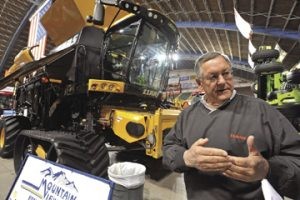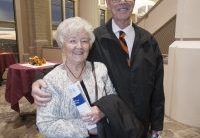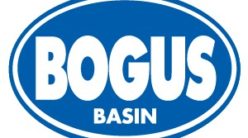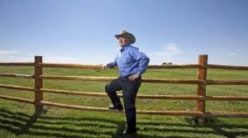Doug Lindley/Idaho State Journal
Joe Vallery, a representative for Claas of America, which is an ag machinery manufacturer, talks about the Claas 780 combine during the Eastern Idaho Ag Expo at Idaho State University’s Holt Arena last week in Pocatello. The combine’s chassis is made in Germany before it’s shipped to an assembly plant in Omaha, Nebraska. He said it’s about 60 percent U.S. content and 40 percent German content.
By Shelbie Harris
sharris@journalnet.com
POCATELLO — It’s surprising there isn’t a space combine at the rate farming equipment is technologically evolving, but that’s not to say someone hasn’t started the development process.
Though it isn’t threshing space corn, the high-tech capabilities of the Lexicon family of Claas combines are, perhaps, out of this world.
The largest model of the Lexicon 780 family, the Claas 10 combine harvester, was on display at Idaho State University’s Holt Arena during the Eastern Idaho Ag Expo last week, where dealer representative Joe Vallery discussed sophisticated new technologies that make these combines top-market equipment.
“We have what’s called an Accelerated Pre-Separation (APS) system that starts our separation process and nobody else has it,” Vallery said. “Right after the grain comes up the feeder chain, it hits the first cylinder that starts the APS process. Then it moves to the threshing cylinder. The crop moves to the accelerator that moves it into two different rotors.”
Claas is an agricultural machinery manufacturer founded in 1913 and based in Germany. The Claas Lexicon comes in 5 different classes with the largest being a class 10, which weighs-in around 37,000 pounds and has a list price of around $700,000.
Equipped with a 523 horsepower Mercedes-Benz engine, the combine’s chassis is manufactured in Germany before it’s shipped to the assembly plant in Omaha, Nebraska.
“The cab, the engine and the yellow parts are all U.S. content,” Vallery said, adding that all North American Claas combines share the same Caterpillar yellow because that’s how it was marketed in the U.S. before CAT got out of the agriculture market in 2002. “Right now it’s about 60 percent U.S. content and 40 percent German content.”
In markets outside of North America, the standard colors are white and light green.
Vallery added that if Claas were to haul the entire combine on a freight container it would cost much more in shipping. By keeping freight costs low, it helps offset the purchase cost for consumers.
Additionally, Vallery said the design of this combine allows threshing where many other machines couldn’t because of its optional front-end track system (as opposed to dual rubber tires) and the Claas-unique 3D Sieve System.
“There’s a pendulum in there that once you hit the hillside it moves, and the sieve inside the combine will counteract,” Vallery said. “It basically throws the grain to the uphill side so you don’t ball up on one side and it will compensate up to 20 percent of the slope.”
With the track system installed, this machine can climb the hills common throughout Southeast Idaho where other machines would struggle. Additional drive in the back is optional, according to Vallery, which only improves the machine’s ability to navigate tough terrain.
“This system is faster and cleaner than other combines,” Vallery said. “We thresh at a higher speed and put less grain out the back.”’
Another standard, cutting-edge technology installed in the Lexicon model is the automated Claas Electronic Machine Optimization System (CEMOS) system.
Initially dialogue-based, this system now allows the combine operator to establish correct situation settings once before the system becomes self-setting for various circumstances.
“The combine will actually compensate for speed of the cylinders and rotors based on the amount of crop you’re moving through,” Vallery said. “This takes more stress off the operator. In normal conditions, the operator has to make those adjustments and in this case it’s done automatically. You set your parameters in the morning and the CEMOS system makes adjustments throughout the day to minimize waste.”
Like many other state-of-the-art combines, GPS steering comes standard, as do leather seats in the cab.
“With leading leg room, this combine is very comfortable for the operator,” Vallery added.
The Claas name is available locally through Mountain View Equipment Company in Idaho Falls. However, the company has international ties around the world.
They have several plants worldwide, with four in Germany, one in Russia, one in China, two in India, and one in North America.
“Claas worldwide has been around over 100 years,” Vallery said. “It’s not a new company and it’s the market leader in forage harvesters in North America. At one point, we made more combines than John Deere.”





